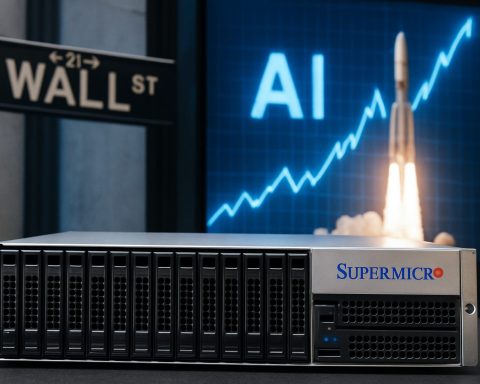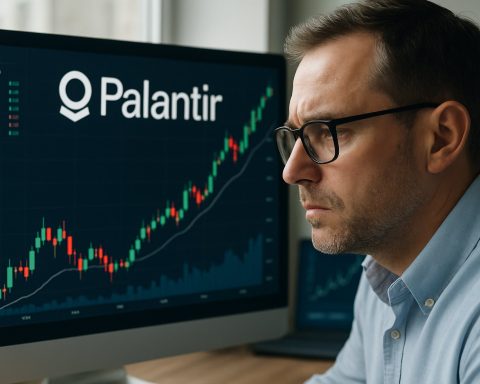- Warren Buffett’s Berkshire Hathaway continues to achieve impressive financial growth, boasting a 20% compound annual growth rate.
- Apple, a significant part of Buffett’s portfolio, has initiated AI developments through Apple Intelligence, aiming to enhance its products like iPhones and Macs.
- The unveiling of Apple Intelligence has yet to make a major impact, with a slight decline in year-over-year iPhone revenue reported for 2025.
- Apple’s upcoming AI upgrade for Siri is delayed until 2026, as competitors advance their AI initiatives.
- Despite criticism, Apple is seen by optimists as focusing on precision and quality rather than speed.
- With over 2.4 billion active devices, Apple has substantial potential for global AI-driven expansion.
- Apple’s high price-to-earnings ratio reflects its perceived value and investor interest, as Buffett remains confident in the company’s future.
Under the golden glow of investment success, Warren Buffett has long orchestrated a symphony of capital allocation at Berkshire Hathaway, transforming it into a beacon of financial triumph with a staggering compound annual growth rate of around 20%. In a twist that surprises many, one of the jewels in Buffett’s vast portfolio indeed glimmers with the promise of Artificial Intelligence (AI)—a fitting paradox given his historical aversion to tech’s edge.
However, the shimmering Apple stock, despite claiming a proud $67 billion chunk of Berkshire’s investments, doesn’t ride the current AI high tide with the breeze its advocates once witnessed. Apple, traditionally lauded for innovation woven with elegance, unveiled Apple Intelligence to the world. Introduced last June but seemingly too late to the party, this AI initiative aimed to inject new life into beloved products like iPhones and Macs through innovative features such as smart editing tools and custom emojis—features that resonated privacy and security, Apple’s favorite anthem.
Yet, the hoped-for crescendo that Apple Intelligence was to bring seems to still wait in the wings. The fiscal curtain rose not to roaring applause but rather a 1% dip in year-over-year iPhone revenue for the first quarter of 2025. The company whispered rather than shouted achievements in markets graced by Apple Intelligence, where the iPhone 16 briefly sparkled. Yet, the allure wasn’t universal.
In a dramatic pivot to realism, Apple has sounded the gong of delay on an eagerly awaited upgrade to Siri, aiming to turn this ubiquitous assistant into a sage-like companion, insightful and deeply knowledgeable. Fans and critics alike will hold their breaths for this transformation until 2026, while tech rivals continue to spill fireworks of innovation across the skies.
Critics raise a clarion call: Why did Apple, towered by resources and brilliance, sidle bashfully behind adversaries like OpenAI who galloped forward in AI revelry with ChatGPT in 2022? But optimists cling to hope, envisioning Apple’s strategy more as a deliberate act of precision and quality assurance, reminiscent of the meticulous craftsmanship that has woven Apple’s product fabric so far.
Once Apple unrolls its anticipated AI-driven offerings, it will tap into a deep vein of opportunity with over 2.4 billion active devices scattered across every corner of the globe. Though the critics’ echoes are loud, remember—the grandeur of Apple’s symphony could well crescendo come 2026, silencing skepticism.
For investors, the allure of Apple shimmers through the lens of a sky-high price-to-earnings ratio of 30, a figure that’s as daunting as it is fascinating. While Buffett’s faith remains resolute, only time will tell if others wish to waltz along. Until then, the wise keep a watchful eye on Apple’s horizon, one that promises a yet unseen confluence of cutting-edge innovation and timeless elegance.
What Lies Ahead for Apple in the AI Revolution: Surprises, Strategies, and Investor Insights
Introduction
Warren Buffett’s investment prowess at Berkshire Hathaway is legendary, with the Apple stock valued at a staggering $67 billion. Historically wary of tech investments, Buffett’s affinity for Apple reveals its undercurrent of innovation—notably in Artificial Intelligence (AI). However, Apple’s venture into the AI arena hasn’t garnered the anticipated applause. This article delves into the intricacies of Apple’s AI journey, investor considerations, and the broader implications for the tech industry.
Current State and Challenges
Apple Intelligence’s Tepid Reception:
– Performance Lag: Apple’s AI efforts, showcased in features like smart editing tools and custom emojis, have yet to capture significant market enthusiasm.
– iPhone Revenue Decline: A 1% drop in iPhone revenue in early 2025 signals lukewarm market reception, contrasting with competitors who are progressing rapidly in AI technology.
AI Strategy of Competitors:
– Industry Peers Advancing Faster: Companies like OpenAI, with its ChatGPT introduced in 2022, have rapidly advanced AI capabilities, leaving Apple playing catch-up.
Strategic Insights and Predictions
Apple’s Methodical Approach:
– Quality Over Speed: Apple’s deliberate approach carries the promise of precision and superior product integration, potentially leading to breakthroughs by 2026.
Future Potential:
– Global Device Ecosystem: With over 2.4 billion active devices, Apple sits poised for a significant AI impact if they can effectively leverage their massive ecosystem.
Investment Perspective
Valuation and Investor Sentiment:
– High P/E Ratio: Apple’s price-to-earnings ratio at 30 suggests high investor expectations, but it carries risk, should the company’s AI strategy falter.
– Warren Buffett’s Stance: His continued confidence in Apple reflects a belief in its long-term innovation potential, despite current struggles.
Actionable Recommendations for Investors
1. Monitor AI Developments:
Keep a keen eye on Apple’s announcements and performance in AI innovations over the next few years.
2. Evaluate Competitor Movements:
Study competitors’ successes and failures in AI to gauge relative progress and insights into potential disruptive technologies.
3. Diversify Investments:
Given the uncertainties, balancing your portfolio with a mix of tech stocks, including both AI leaders and other sectors, might mitigate risk.
Comparison and Market Trends
AI Technology Across Tech Giants:
– Features and Innovation: Compare Apple’s AI applications with those of peers like Google and Microsoft to evaluate the real-world impact and user adoption of AI functionalities.
– Sustainability and Security: Apple’s focus on privacy and security in AI applications could differentiate it amid increasing regulatory scrutiny.
Conclusion
While Apple’s foray into AI seems understated for now, the groundwork laid could lead to substantial influence and market shifts by 2026. For those invested in tech and innovation, Apple’s AI journey warrants close attention. Investors should balance trust in Apple’s meticulous strategy with the agility exemplified by its competitors. The unfolding AI narrative at Apple could redefine not just a company but the entire technological landscape.
Related Resource Links
For further insights on investment strategies and technology analysis, explore these resources:
– Berkshire Hathaway
– Apple
By keeping informed and adaptable, investors can position themselves advantageously as the next wave of AI innovation rolls in.








